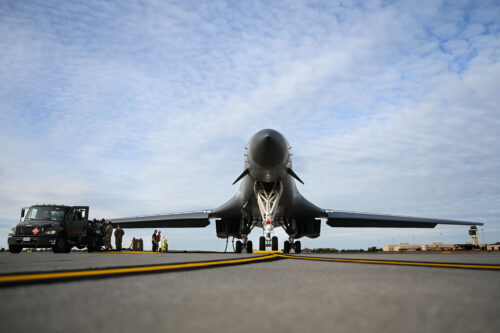The B-1 Lancer demonstrated its global reach on 1 Oct., participating in events both in the United States and in South Korea.

U.S. Air Force photo by Senior Yendi Borjas
At Grand Forks Air Force Base (GFAFB), North Dakota, a B-1B Lancer assigned to the 28th Bomb Wing participated in a hot-pit refuelling operation, a procedure that involves refuelling the aircraft while the engine is still running. This exercise was designed to test the adaptability of GFAFB, which is the proposed temporary location for Ellsworth Air Force Base’s B-1 fleet during a runway construction project. The construction is in preparation for the future arrival of the B-21 Raider, the Air Force’s next-generation stealth bomber.
The hot-pit refuelling took place 30 years after the last B-1B Lancer left GFAFB in 1994. “The ability to perform a hot-pit in an alternate location proves our ability to continue operating at 100 percent no matter where we are,” said Staff Sgt. Jacob Szatkowski, a dedicated crew chief with the 37th Bomber Generation Squadron.
Airmen travelled to GFAFB to test the equipment and to foster relationships with the 319th Reconnaissance Wing, which is currently based at GFAFB. “As of now we have worked with the 319th Reconnaissance Wing to accomplish runway and airfield familiarization, as well as coordination for aircraft movement,” said Szatkowski. “The relationships built during this trip helped break the ice for any coordination needed in months to come.”
Lt. Col. Nathaniel Butler, Commander Action Group director, expressed satisfaction with the exercise. “I was really happy to see our bomber come and land here,” he said. “Everything went exactly as we intended. It is always good to see the aircraft performing exactly as needed, and the fact this base is adequately appointed to support our operations works in our favor.”
The successful hot-pit refuelling demonstrated the Air Force’s commitment to maintaining bomber mission readiness, even during base construction projects. The temporary relocation of the B-1 fleet to GFAFB is expected to last 10 months, starting in February 2025. During this time, approximately 800 Airmen will be deployed to GFAFB to maintain bomber operations.
On the same day, thousands of miles away in South Korea, another B-1B Lancer participated in a combined flyover with two Republic of Korea Air Force (ROKAF) F-16K Slam Eagles over Seongnam’s Seoul Air Base. The flyover was part of a celebration to mark the 76th anniversary of the founding of the ROK Armed Forces.
Earlier that day, two B-1s also took part in simulated close air support training with two ROKAF F-15Ks and personnel from the U.S. 607th Air Support Operations Group at Pilsung Range in South Korea. This event marked the second time in 2024 that B-1s had conducted close air support training in South Korea, following a previous exercise in early June.
The B-1B’s participation in the ROK Armed Forces Day celebration served as a powerful demonstration of the strong alliance between the United States and South Korea.
For more information, hit the Source below